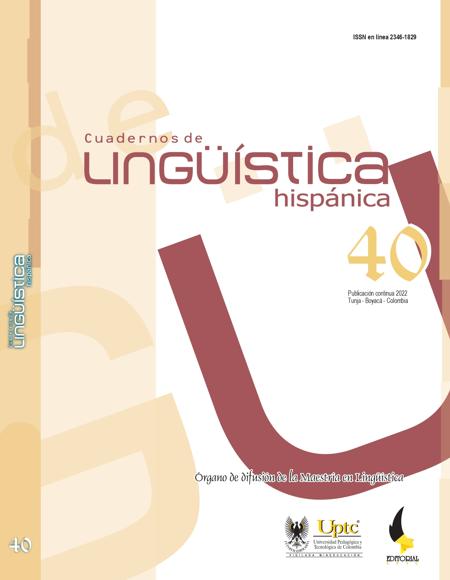Learning with Graffiti: Spanish Students Facing the Tabooed Linguistic Landscape

Abstract
During academic exchanges, students are in contact with the linguistic landscape (LL). In this paper, we aimed to characterize the linguistic attitudes of Spanish as SL or FL students towards the linguistic taboo (LT). For that, we collected samples of tabooed signs detected inside the restrooms of a university. The data was in surveys of students who were in face-to-face or online language immersion. With the samples collected, we describe the tabooed LL with which those who carried out the face-to-face exchange were in contact. The results of the surveys made it possible to investigate the students’ knowledge of tabooed expressions in Spanish and, in addition, to characterize their linguistic attitudes towards LT. We conclude that the students, although they show a predisposed linguistic attitude to deal with LT, lack the communicative competence that would allow them to be competent users in relation to taboo expressions. Thus, this type of experience justifies the need to include the LT as part of the contents of the Spanish as a SL or FL class.
Keywords
linguistic landscape, linguistic taboo, linguistic attitudes, on-site and online linguistic and cultural immersion, Spanish as a SL or FL
References
- Agheyisi, R., & Fishman, J. A. (1970). Language Attitude Studies: A Brief Survey of Methodological Approaches. Anthropological Linguistics, 12(5), 137-157.
- Allan, K. (2018). Foreword. In A. Pizarro Pedraza (ed.), Linguistic Taboo Revisited. Novel Insights from Cognitive Perspectives (pp. V-VIII). De Gruyter Mouton.
- Allan, K., & Burridge, K. (2006). Forbidden Words: Taboo and the Censoring of Language. Cambridge University Press. https://doi.org/10.1017/CBO9780511617881
- Backhaus, P. (2006). Multilingualism in Tokyo: A Look into the Linguistic Landscape. Linguistic Landscape: A New Approach to Multilingualism, 3(1), 52-67.
- Bassili, J. N., & Brown, R. D. (2005). Implicit and Explicit Attitudes: Research, Challenges, and Theory. In The Handbook of Attitudes (pp. 543-576). Lawrence Erlbaum Associates Publishers.
- Bonnin, J. E. & Unamuno, V. (Eds.). (2019). Dossier. Paisajes lingüísticos en el mundo hispánico: razones a favor, en contra y un montón de artículos. Signo y Seña, 35, 1-106. http://revistascientificas.filo.uba.ar/index.php/sys/issue/view/561
- Brown, P., & Levinson, S. C. (1987). Politeness, Some Universals in Language Usage. Cambridge University Press.
- Castillo Lluch, M. & Sáez Rivera, D. M. (2011). Introducción al paisaje lingüístico de Madrid. Lengua y Migración, 3(1), 73-88.
- Cestero Mancera, A. M. (2015a). Estudio sociolingüístico del tabú en el habla de Madrid: propuesta metodológica y primeros resultados. En I. Molina Martos, A. M. Cestero Mancera & F. Paredes García (eds.), Patrones sociolingüísticos de Madrid (pp. 287-348). Peter Lang.
- Cestero Mancera, A. M. (2015b). La expresión del tabú: estudio sociolingüístico. Boletín de Filología, 50(1), 71-105. https://doi.org/10.4067/S0718-93032015000100003
- Cestero Mancera, A. M. & Mayo Martín, P. (2022). Guía PRESEEA de estudio de la expresión del tabú. Editorial Universidad de Alcalá. https://doi.org/10.37536/PRESEEA.2022.guia12
- Cestero Mancera, A. M. & Paredes, F. (2015). Creencias y actitudes hacia las variedades normativas del español actual. Primeros resultados del Proyecto PRECAVES-XXI. Spanish in Context, 12(2), 255-279. https://doi.org/10.1075/sic.12.2.04ces
- Duart, J. & Sangrà, A. (Eds.). (2000). Aprender en la virtualidad. Gedisa.
- Fasold, R. (1996). Las actitudes lingüísticas. En La sociolingüística de la sociedad. Introducción a la sociolingüística (pp. 229-274). Visor Libros.
- Gorter, D. (2006). Introduction: The Study of the Linguistic Landscape as a New Approach to Multilingualism. International Journal of Multilingualism, 3(1), 1-6.
- Gumperz, J. (Ed.). (1982). Discourse Strategies. Cambridge University Press.
- Hipperdinger, Y. (Ed.). (2019). Español y otras lenguas en el área dialectal bonaerense del español de la Argentina. EdiUNS.
- Hipperdinger, Y. (2020). Paisaje lingüístico institucional en el área dialectal bonaerense: la promoción de la enseñanza de lenguas. Cuadernos de Literatura, Revista de Estudios Lingüísticos y Literatura, (15), 50-62. https://doi.org/10.30972/clt.0154706
- Landry, R., & Bourhis, R. Y. (1997). Linguistic Landscape and Ethnolinguistic Vitality: An Empirical Study. Journal of Language and Social Psychology, 16(1), 23-49. https://doi.org/10.1177/0261927X970161002
- López Morales, H. (1993). Sociolingüística (2.a ed.). Gredos.
- Pizarro Pedraza, A. (2013). Tabú y eufemismo en la ciudad de Madrid. Estudio sociolíngüístico-cognitivo de los conceptos sexuales [Tesis doctoral]. Universidad Complutense de Madrid, Madrid.
- Pons Rodríguez, L. (2011). Hispanoamérica en el paisaje lingüístico de Sevilla. Itinerarios, 13, 97-129.
- Simón, L. (2016). La enseñanza de una lengua extranjera utilizando tecnología digital: estudio descriptivo del tránsito de un material impreso a un entorno virtual de aprendizaje [Magíster en Tecnología Informática Aplicada en Educación]. Universidad Nacional de La Plata. https://doi.org/10.35537/10915/59236
- Starc, M., Fainstein, P., Scoppa, M. L., Benedetti, L. & de-Matteis, L. (2016). La cultura en los cursos ELE de la UNS. En El español: Retos y oportunidades económicas y formativas en un contexto global. Septem Ediciones.
- Tannen, D. (2004). Interactional Sociolinguistics. In U. Ammon, N. Dittmar, K. J. Mattheier, & P. Trudgill (Eds.), Sociolinguistics: An International Handbook of the Science of Language and Society (pp. 76-88). Walter de Gruyter.
- West, M. & Vosloo, S. (2013). Directrices para las políticas de aprendizaje móvil. Unesco.
